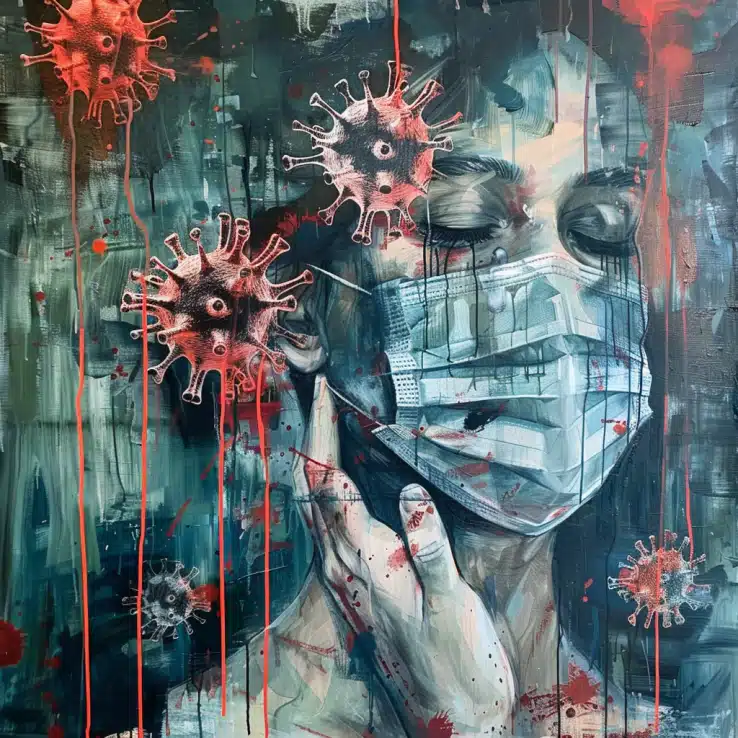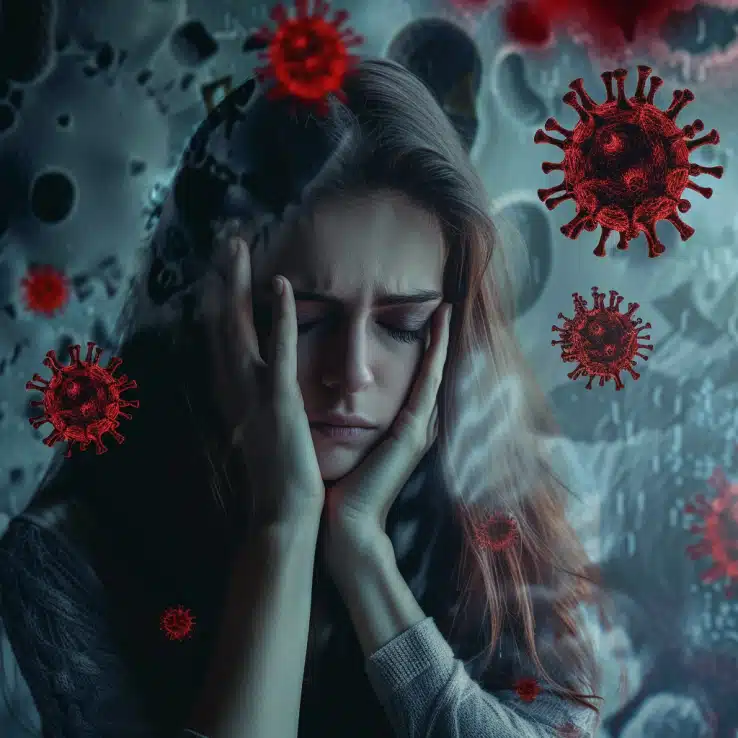TLDR: A study in the UK found that severe COVID anxiety tends to decrease over 6 months from onset, both organically and with the help of CBT for Health Anxiety (CBT-HA), though many individuals still experience significant anxiety and poor social functioning, with health anxiety being a key factor that can be effectively targeted with CBT-HA.
Highlights:
- Decline in COVID Anxiety: COVID anxiety levels fell significantly from 12.4 to 6.8 over 6 months.
- Predictors of Anxiety Reduction: Younger age, higher initial COVID anxiety, and lower health anxiety at baseline were associated with greater reductions in COVID anxiety.
- Effectiveness of CBT-HA: In a feasibility trial, those receiving CBT-HA showed improved mental health and social functioning compared to the control group.
- Persistent High Anxiety: Despite overall improvement, a significant minority continued to experience high anxiety and poor social functioning.
- Target for Treatment: Health anxiety was prevalent and could be a promising target for psychological interventions to help those with severe COVID anxiety.
Source: BMC Psychiatry (2024)
Estimated Prevalence of Health Anxiety & COVID Anxiety
Health Anxiety
- General Population: Health anxiety is estimated to affect around 5-10% of the general population.
- COVID Context: The pandemic has likely exacerbated health anxiety, particularly among those already predisposed to anxiety disorders.
COVID Anxiety
- Early Pandemic Estimates: Studies during the early stages of the pandemic indicated that up to 30-40% of individuals experienced significant anxiety related to COVID-19.
- Severe COVID Anxiety: Approximately 5-10% of the population may experience severe COVID anxiety, characterized by high levels of fear and behavioral avoidance beyond public health recommendations.
Causes of Severe COVID Anxiety
Severe COVID anxiety is often driven by several interrelated factors:
- Fear of Infection: The fear of contracting COVID-19 and concerns about its potential health impacts are primary causes. This fear is heightened by the perceived severity of the virus, particularly during the early stages of the pandemic when the morbidity and mortality rates were high.
- Media Consumption: Continuous exposure to alarming news and information about COVID-19 can exacerbate anxiety. People with severe COVID anxiety tend to spend more time reading about the virus, which can create a feedback loop of fear and anxiety.
- Social Isolation: The lockdowns and social distancing measures implemented to control the spread of the virus led to increased feelings of loneliness and isolation, contributing to higher anxiety levels.
- Economic Hardship: Financial instability and job insecurity resulting from the pandemic have added significant stress, which can manifest as heightened anxiety.
- Health Anxiety: For many individuals, the pandemic has amplified pre-existing health anxieties. The constant worry about their health and the health of loved ones can lead to severe COVID anxiety.
Signs & Symptoms of COVID Anxiety

COVID anxiety, also referred to as coronavirus anxiety, encompasses a range of emotional, cognitive, and behavioral responses that individuals may experience due to fear and stress related to the COVID-19 pandemic.
The symptoms can vary in intensity and impact daily functioning. Common signs and symptoms include:
Emotional Symptoms
Persistent Worry: Constant and excessive worry about contracting COVID-19, even in situations where the risk is minimal.
Fear of Infection: Intense fear of becoming infected or infecting loved ones, which can lead to avoidance behaviors.
Irritability and Agitation: Increased irritability and restlessness due to ongoing stress and uncertainty about the pandemic.
Sadness or Depression: Feelings of hopelessness, sadness, or depression, particularly when thinking about the pandemic’s impact.
Cognitive Symptoms
Intrusive Thoughts: Recurrent, distressing thoughts about COVID-19, such as imagining oneself or loved ones getting seriously ill.
Catastrophic Thinking: Expecting the worst possible outcomes, such as severe illness or death, even when these outcomes are unlikely.
Difficulty Concentrating: Trouble focusing on tasks or making decisions due to preoccupation with COVID-19-related concerns.
Hypervigilance: Heightened awareness and constant monitoring of one’s own health and the health of others for symptoms of COVID-19.
Physical Symptoms
Somatic Complaints: Physical symptoms such as headaches, muscle tension, gastrointestinal issues, and fatigue, which may be exacerbated by stress.
Sleep Disturbances: Difficulty falling asleep, staying asleep, or experiencing restful sleep due to anxiety and worry.
Increased Heart Rate: Palpitations or a racing heart when thinking about COVID-19 or encountering related triggers.
Breathing Difficulties: Shortness of breath or hyperventilation, often triggered by anxiety or panic attacks.
Behavioral Symptoms
Avoidance Behaviors: Avoiding places or activities perceived as risky, such as public transportation, social gatherings, or even necessary medical appointments.
Excessive Hygiene Practices: Engaging in excessive handwashing, sanitizing, or cleaning behaviors beyond recommended guidelines.
Checking and Reassurance-Seeking: Frequently checking for symptoms of COVID-19, seeking reassurance from medical professionals, or repeatedly checking news updates.
Social Withdrawal: Reducing or avoiding social interactions, even virtually, due to fear of infection or general anxiety.
Functional Impairment
Impact on Daily Life: COVID anxiety can interfere with daily activities, work, and social relationships, leading to decreased productivity and quality of life.
Reduced Engagement: Loss of interest in previously enjoyed activities or reluctance to engage in routine tasks due to anxiety.
Major Findings: CBT-HA for COVID Anxiety in UK (2024)
The study yielded several significant findings related to the course of severe COVID anxiety and the effectiveness of Cognitive Behavioural Therapy for Health Anxiety (CBT-HA):
Reduction in COVID Anxiety Over Time
Among the 204 participants who completed the six-month follow-up, levels of COVID anxiety significantly decreased from an average score of 12.4 at baseline to 6.8 at six months (mean difference = -5.5, 95% CI = -6.0 to -4.9).
Influencing Factors on Anxiety Reduction
- Age: Older participants experienced smaller reductions in COVID anxiety compared to younger participants.
- Living with a Vulnerable Person: Participants living with someone vulnerable to COVID-19 had smaller reductions in COVID anxiety.
- Baseline Anxiety Levels: Higher baseline COVID anxiety was associated with larger reductions over time.
- Generalized Anxiety and Health Anxiety: Participants with higher levels of generalized anxiety (GAD-7) and health anxiety (sHAI) at baseline had smaller reductions in COVID anxiety.
Feasibility Trial of CBT for Health Anxiety
- Uptake and Adherence: Of the 40 participants in the feasibility trial, 90.5% attended at least one session of CBT-HA, and 81.0% attended four or more sessions, indicating good adherence to the intervention.
- Follow-up Completion: 90.0% of the trial participants completed the six-month follow-up, with 95.2% in the intervention arm and 84.2% in the control arm.
- Improvement in Mental Health and Social Functioning: Participants in the CBT-HA group showed significant improvements in mental health and social functioning compared to the control group:
- Work and Social Adjustment Scale (WSAS): Mean difference in total score from baseline to follow-up was 9.7 (95% CI = 5.8–13.6) in the active arm, versus 1.0 (95% CI = -4.6 to 6.6) in the control arm.
- Health Anxiety (sHAI): Reduction in sHAI scores was significantly greater in the CBT-HA group (mean difference = 10.83, 95% CI = 7.6–14.1) compared to the control group (mean difference = 4.57, 95% CI = -0.1 to 9.2).
- Generalized Anxiety (GAD-7): The intervention group showed a greater reduction in GAD-7 scores (mean difference = 7.02, 95% CI = 4.4–9.6) compared to the control group (mean difference = 3.40, 95% CI = -0.5 to 7.3).
- Depression (PHQ-9): Reduction in PHQ-9 scores was significantly higher in the intervention group (mean difference = 7.85, 95% CI = 5.1–10.6) compared to the control group (mean difference = 1.33, 95% CI = -3.2 to 5.9).
Persistent Anxiety & Social Dysfunction
Despite overall improvements, a substantial minority of participants continued to experience high levels of anxiety and significant social dysfunction.
At six-month follow-up, a notable proportion of participants reported ongoing avoidance behaviors, such as buying all food online (26.1%) and never leaving their home (9.8%).
Targeting Health Anxiety
The prevalence of health anxiety among participants with severe COVID anxiety suggests that health anxiety is a critical target for psychological treatment.
The significant improvements observed in the CBT-HA group support the potential of this intervention to effectively address severe COVID anxiety and associated health anxiety.
Study Details: Severe COVID Anxiety in UK Adults (2024)

The primary aim of the study was to examine the course of severe COVID anxiety over a six-month period among individuals in the UK.
The secondary aims included generating hypotheses about clinical and demographic factors associated with changes in COVID anxiety levels.
Additionally, researchers tested Cognitive Behavioural Therapy for Health Anxiety (CBT-HA) for improving mental health and social functioning in individuals with severe COVID anxiety and co-existing health anxiety.
Methods
Design:
- Cohort Study: A quantitative cohort study to track levels of COVID anxiety over six months.
- Nested Feasibility Trial: A parallel-arm, single (researcher) masked feasibility trial to test remotely delivered CBT-HA against treatment as usual.
Participants:
- Recruitment: Participants aged 18 and over, residing in the UK, recruited online and from primary care services.
- Eligibility: Severe COVID anxiety (CAS score ≥ 9), no recent COVID-19 diagnosis, not currently self-isolating, and not receiving psychological treatment.
- Feasibility Trial: Participants scoring ≥ 20 on the Short Health Anxiety Inventory (sHAI).
Outcomes
- Primary: COVID anxiety levels (measured by the Coronavirus Anxiety Scale, CAS).
- Secondary: Mental health (PHQ-9, GAD-7), social functioning (WSAS), and health anxiety (sHAI).
Limitations
- Self-Selection Bias: Participants were self-selected through online recruitment, which may not be representative of all individuals with severe COVID anxiety in the UK.
- Gender Imbalance: The sample consisted predominantly of women (80%), limiting the generalizability of findings to men.
- Short Follow-Up Period: The study followed participants for six months, which may not capture the long-term course of severe COVID anxiety.
- Lack of Pre-Pandemic Data: All data were collected post-pandemic onset, making it difficult to assess the impact of pre-existing mental health conditions.
- Online Recruitment: Relied on internet access, excluding those without it.
Comparing CBT-HA vs. Doing Nothing (No Intervention)
The study compared the effectiveness of Cognitive Behavioural Therapy for Health Anxiety (CBT-HA) to no specific intervention (treatment as usual) in reducing severe COVID anxiety and improving overall mental health and social functioning.
The findings indicate that CBT-HA was significantly more effective than doing nothing – but not necessarily but a lot in all metrics.
Reduction in COVID Anxiety
- CBT-HA Group: Participants who received CBT-HA showed a mean reduction of 7.0 points on the Coronavirus Anxiety Scale (CAS) from baseline to six months.
- Control Group: Participants in the control group, who received no specific intervention, experienced a mean reduction of 5.94 points on the CAS over the same period.
Mental Health & Social Functioning
- Depression (PHQ-9): The CBT-HA group had a mean reduction of 7.85 points, whereas the control group had a mean reduction of 1.33 points.
- Generalized Anxiety (GAD-7): The CBT-HA group showed a mean reduction of 7.02 points, compared to 3.40 points in the control group.
- Health Anxiety (sHAI): The reduction in health anxiety was significantly greater in the CBT-HA group (mean reduction of 10.83 points) compared to the control group (mean reduction of 4.57 points).
- Social Functioning (WSAS): The CBT-HA group had a mean improvement of 9.7 points, while the control group only improved by 1.0 point.







